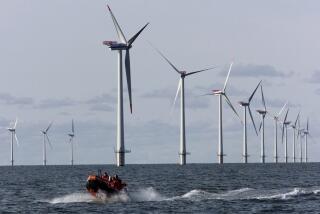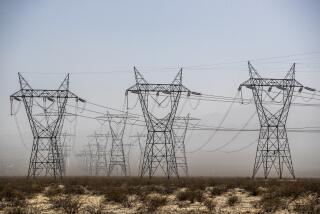There’s a New Wind Blowing in Field of Energy : Technology: High-tech windmills already are generating power at several California locations. Now they are envisioned for the Pacific Northwest, the Midwest and New England.
- Share via
LIVERMORE, Calif. — From a distance, they look like tall, gawky, stilt-legged fans trying to cool the parched hills.
Their arms move languidly in the light wind, but they are still an impressive sight. The 7,300 wind-turbine towers in the Altamont Pass outside Livermore, about 30 miles south of San Francisco, constitute the largest wind-fueled power plant in the world.
About 8,700 other high-tech windmills capture breezes in California. Most of them are clustered in two other blustery California passes, one not far from Palm Springs and the other near Mojave.
The wind farms perform best in the summer and early fall, when cool air from the Pacific creates powerful currents that sweep through the passes.
Wind moves blades on the machines, driving turbines that create electrical energy, which is then fed into a utility’s power grid.
Until recently, American wind power has been concentrated in California and, to a lesser extent, in Hawaii; the few wind turbines in other parts of the country have not convinced most utilities that the future rides on windmill blades.
But that could quickly change. Ambitious wind-power projects are envisioned for many gusty areas of the country, including the Pacific Northwest, the Midwest and New England.
U.S. plans are mere zephyrs compared with some gale-force ventures sweeping Europe. “Wind-power projects there are expected to dwarf U.S. efforts in the 1990s, unless things change,” said Randall Swisher, executive director of the American Wind Energy Assn. in Washington, D.C.
California’s wind turbines produced 3 billion kilowatt hours of electricity in 1992, enough energy to meet the needs of about 400,000 homes for a year.
Tax breaks and state policies spurred development of wind energy in California, but it slacked off after the incentives disappeared in 1985. Recent advances in technology have breathed new life into the power source.
Successors to the humble windmills that once graced rural America, modern versions can tower 200 feet and feature turbines powered by 2,000-pound, aerodynamically designed blades. Sensors automatically shift turbines when wind direction changes, and central computers can monitor each unit on a wind farm.
Such advances have lowered costs to the point where wind power is fast becoming competitive with traditional energy sources such as oil and coal.
“Wind power has worked diligently to reduce its cost, and that is the key for its long-term implementation,” Earl Davis, a wind-power expert at the Electric Power Research Institute in Palo Alto, Calif., told National Geographic.
Advocates note that the wind is a free, renewable, non-polluting energy source. Wind-power plants in California reportedly kept more than 2.9 billion pounds of carbon dioxide and 16 million pounds of other pollutants out of the air in 1991.
Utilities save, too, because when their high-tech windmills are spinning, they can turn off power generators that burn coal, gas or oil.
But even big utilities such as Pacific Gas & Electric, which helped pioneer wind power in California, do not see it as a panacea. “I think the future is going to be made up of a whole portfolio of different technologies working together,” said Carl Weinberg, the company’s research and development manager.
“Still other parts of the country should be thinking of wind as part of the mix. California isn’t the breeziest place in the country, but at times wind has provided as much as 8% of our power.”
North Dakota and South Dakota, on the gusty Great Plains, are among the states that show plenty of promise.
One study shows that North Dakota alone has enough potential wind energy to supply more than one-third of the electrical consumption of the contiguous 48 states. “If there was a way to get that wind energy from the Dakotas to load centers such as Chicago, then I think wind-farm development would be very significant much sooner,” Davis said.
The first substantial U.S. wind farm outside California and Hawaii--with as many as 80 machines--could begin whirring in southwestern Minnesota as early as 1994, generating some electricity for the Minneapolis-St. Paul area.
Kenetech-U.S. Wind Power, a big turbine manufacturer and wind-plant developer in Livermore, is negotiating with utilities in the Pacific Northwest to set up a 140-turbine wind farm near Richland, Wash., that would provide energy to parts of Washington, Oregon and Idaho as early as 1995.
“As many as 280 turbines could be feeding power grids in the region by 1997, providing enough energy to serve about 20,000 households,” said Barrett Stambler, the company’s business-development manager.
“The European programs, heavily backed by subsidies, call for the installation of 4,000 megawatts of wind-generating capacity by the year 2000, enough to provide the energy demands of 3 million people,” Swisher said.
“In contrast, the United States has no national goals for the development of renewable energy in general, or for wind energy specifically, but I sense new policies in the offing.”
The most wind-conscious European countries are Denmark, Great Britain, Germany, Italy, the Netherlands and Spain.
Most experts concur that environmental concerns such as acid rain and greenhouse gases from fossil fuels have tilted Europeans toward wind power and left utilities with few alternatives.
“In the European countries, the decision to use wind power has already been made by the government and the people, so the question the utilities there face is how they are going to use it, not whether they are going to use it,” said Edgar DeMeo of the Electric Power Research Institute.
In Canada, more wind generation will be installed in the province of Alberta this year than in the entire United States, Swisher predicts.
More to Read
Inside the business of entertainment
The Wide Shot brings you news, analysis and insights on everything from streaming wars to production — and what it all means for the future.
You may occasionally receive promotional content from the Los Angeles Times.










